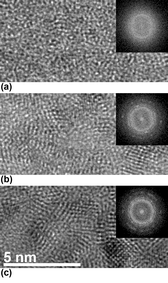Crossref Citations
This article has been cited by the following publications. This list is generated based on data provided by
Crossref.
Tengstrand, Olof
Nedfors, Nils
Andersson, Matilda
Lu, Jun
Jansson, Ulf
Flink, Axel
Eklund, Per
and
Hultman, Lars
2014.
Model for electron-beam-induced crystallization of amorphous Me–Si–C (Me = Nb or Zr) thin films.
Journal of Materials Research,
Vol. 29,
Issue. 23,
p.
2854.
Folkenant, M.
Nygren, K.
Malinovskis, P.
Palisaitis, J.
Persson, P.O.Å.
Lewin, E.
and
Jansson, U.
2015.
Structure and properties of Cr–C/Ag films deposited by magnetron sputtering.
Surface and Coatings Technology,
Vol. 281,
Issue. ,
p.
184.
Meng, Qingnan
Malinovskis, Paulius
Nedfors, Nils
Mao, Fang
Andersson, Matilda
Sun, Youhong
and
Jansson, Ulf
2015.
Characterization of amorphous Zr–Si–C thin films deposited by DC magnetron sputtering.
Surface and Coatings Technology,
Vol. 261,
Issue. ,
p.
227.
Nygren, Kristian
Andersson, Anna Mikaela
Eklund, Per
and
Jansson, Ulf
2017.
Passive films on nanocomposite carbide coatings for electrical contact applications.
Journal of Materials Science,
Vol. 52,
Issue. 13,
p.
8231.
Malinovskis, P.
Palisaitis, J.
Persson, P.O.Å.
Jansson, U.
and
Lewin, E.
2017.
Synthesis and characterisation of Mo-B-C thin films deposited by non-reactive DC magnetron sputtering.
Surface and Coatings Technology,
Vol. 309,
Issue. ,
p.
506.
Lewin, Erik
Counsell, Jonathan
and
Patscheider, Jörg
2018.
Spectral artefacts post sputter-etching and how to cope with them – A case study of XPS on nitride-based coatings using monoatomic and cluster ion beams.
Applied Surface Science,
Vol. 442,
Issue. ,
p.
487.
Mahmoud, Safwat A.
Al-Dumiri, Ashjan A.
and
Al-Hossainy, Ahmed F.
2020.
Combined experimental and DFT-TDDFT computational studies of doped [PoDA+PpT/ZrO2]C nanofiber composites and its applications.
Vacuum,
Vol. 182,
Issue. ,
p.
109777.
Li, Zifeng
Liu, Guotan
Liu, Guanqi
Zhu, Xiaoshuo
and
Fu, Yudong
2021.
Deposition of Nb-Si-C Thin Films by Radio Frequency Magnetron Sputtering.
Coatings,
Vol. 11,
Issue. 5,
p.
524.
Kroker, Michael
Souček, Pavel
Zábranský, Lukáš
Buršíková, Vilma
Czigány, Zsolt
Sochora, Vjačeslav
Balázsi, Katalin
Jílek, Mojmír
and
Vašina, Petr
2023.
Industrially deposited hard and damage resistant W-B-C coatings.
Surface and Coatings Technology,
Vol. 454,
Issue. ,
p.
129150.
Huseynov, T. Z.
Bakieva, O. R.
Khametova, E. F.
Valeev, R. G.
and
Beltyukov, A. N.
2023.
Study of the Chemical Composition of a Multilayer C/Co/Cr System by Low-Energy Ion-Beam Action.
Journal of Surface Investigation: X-ray, Synchrotron and Neutron Techniques,
Vol. 17,
Issue. S1,
p.
S310.
Javed, Zeshan
Rasool, Raqiqa Tur
Alhummiany, Haya
Majeed, Abdul
Gulbadan, Shagufta
Ashraf, Ghulam Abbas
Al-Anazy, Murefah mana
Irfan, M.
Yousef, El Sayed
Akhtar, Majid Niaz
Arshad, Muhammad
and
Khan, Muhammad Azhar
2024.
Structural, morphological, dielectric, and spectral properties of Sr-Mg-Ho X-type magnetic nano materials suitable for microwave absorption application.
Vacuum,
Vol. 222,
Issue. ,
p.
112965.





